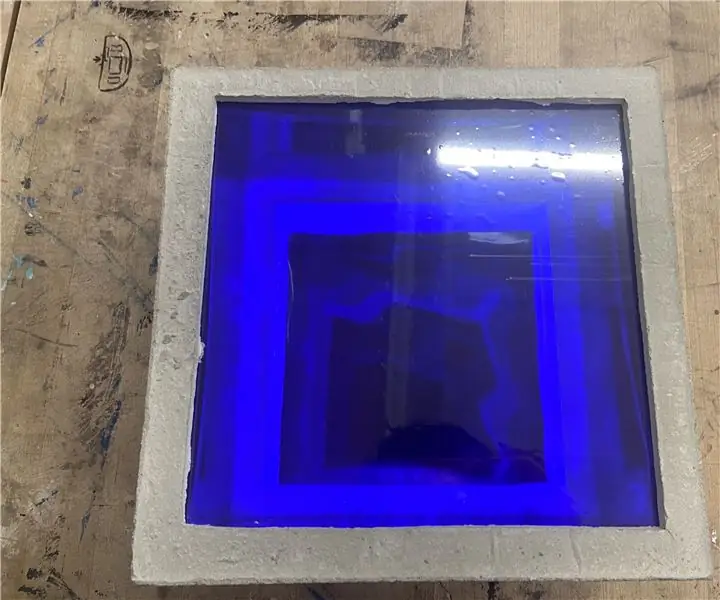
Inhoudsopgave:
- Auteur John Day [email protected].
- Public 2024-01-30 11:16.
- Laatst gewijzigd 2025-01-23 15:01.

Dit is een kunstwerk van een LED-lichtapparaat voor mijn sculptuurproject genaamd Sacred Object. Ik gebruik dit apparaat om een inzending voor een nieuwe wereld te presenteren. Als ik de LED-lamp aanzet, zien we een oneindige tunnel in de betonnen doos. De LED-strip wordt bediend via bluetooth op mijn telefoon. Ik heb alle benodigdheden op Amazon gekocht.
Materialen:
- Arduino Uno
-Loden strip
-9v batterij
-DSD Tech SH-HC-08 Bluetooth 4.0 BLE slave-module
-330 Ohm weerstand
- iPhone
-Beton
-Acryl
- Raamfolie (eenrichtingsspiegel)
-Dubbele zijspiegel film
Stap 1: Circuitontwerp
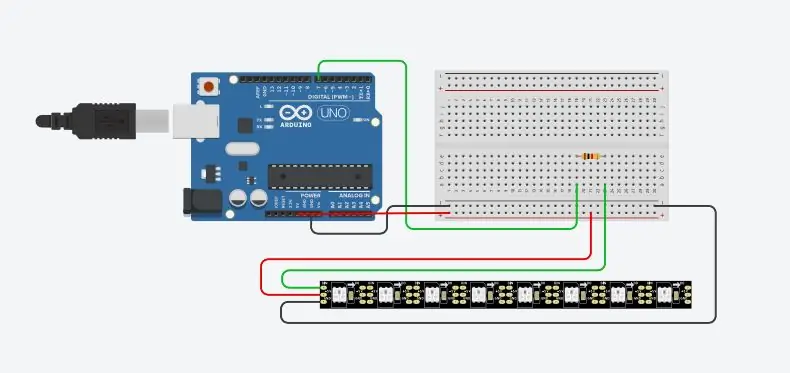

Zo laat ik de schakeling werken. Ik heb ook een reeks gemaakt om een beweging van hersengolven te simuleren.
Eerste afbeelding is de ledstripschakeling.
Tweede afbeelding is het Bluetooth-circuit. De app op de iPhone is BluetoothLED.
Stap 2: Arduino-code
#erbij betrekken
#define LED_PIN 7 #define NUM_LEDS 60 CRGB-leds [NUM_LEDS];
void setup () { pinMode (LED_PIN, OUTPUT); Serieel.begin(9600); FastLED.addLeds (leds, NUM_LEDS); }
void setBlue(int val){ for (int i = 0; i< NUM_LEDS; i++) { leds = CRGB (0, 0, val); } FastLED.show(); } ongeldige lus() {
if(Serial.available()) { val = Serial.read(); } if(val == 'H'){ leds[0] = CRGB(0, 0, 0); FastLED.show(); leds [1] = CRGB(0, 0, 0); FastLED.show(); leds [2] = CRGB(0, 0, 0); FastLED.show(); leds [3] = CRGB(0, 0, 0); FastLED.show(); leds [4] = CRGB(0, 0, 0); FastLED.show();
leds [5] = CRGB(0, 0, 0); FastLED.show();
leds [6] = CRGB(0, 0, 0); FastLED.show();
leds [7] = CRGB(0, 0, 0); FastLED.show();
leds [8] = CRGB(0, 0, 0); FastLED.show();
leds [9] = CRGB(0, 0, 0); FastLED.show();
leds [10] = CRGB(0, 0, 0); FastLED.show();
leds[11] = CRGB(0, 0, 0); FastLED.show();
leds [12] = CRGB(0, 0, 0); FastLED.show();
leds [13] = CRGB(0, 0, 0); FastLED.show();
leds [14] = CRGB(0, 0, 0); FastLED.show();
leds [15] = CRGB(0, 0, 0); FastLED.show();
leds [16] = CRGB(0, 0, 0); FastLED.show();
leds [17] = CRGB(0, 0, 0); FastLED.show();
leds [18] = CRGB(0, 0, 0); FastLED.show();
leds [19] = CRGB(0, 0, 0); FastLED.show();
leds [20] = CRGB(0, 0, 0); FastLED.show();
leds [21] = CRGB(0, 0, 0); FastLED.show();
leds [22] = CRGB(0, 0, 0); FastLED.show();
leds [23] = CRGB(0, 0, 0); FastLED.show(); leds [24] = CRGB(0, 0, 0); FastLED.show();
leds [25] = CRGB(0, 0, 0); FastLED.show();
leds [26] = CRGB(0, 0, 0); FastLED.show();
leds [27] = CRGB(0, 0, 0); FastLED.show();
leds [28] = CRGB(0, 0, 0); FastLED.show();
leds [29] = CRGB(0, 0, 0); FastLED.show();
leds [30] = CRGB(0, 0, 0); FastLED.show(); leds [31] = CRGB(0, 0, 0); FastLED.show();
leds [32] = CRGB(0, 0, 0); FastLED.show();
leds [33] = CRGB(0, 0, 0); FastLED.show(); leds [34] = CRGB(0, 0, 0); FastLED.show();
leds [35] = CRGB(0, 0, 0); FastLED.show();
leds [36] = CRGB(0, 0, 0); FastLED.show();
leds [37] = CRGB(0, 0, 0); FastLED.show();
leds [38] = CRGB(0, 0, 0); FastLED.show();
leds [39] = CRGB(0, 0, 0); FastLED.show();
leds [40] = CRGB(0, 0, 0); FastLED.show();
leds [41] = CRGB(0, 0, 0); FastLED.show();
leds [42] = CRGB(0, 0, 0); FastLED.show();
leds [43] = CRGB(0, 0, 0); FastLED.show(); leds [44] = CRGB(0, 0, 0); FastLED.show();
leds [45] = CRGB(0, 0, 0); FastLED.show();
leds [46] = CRGB(0, 0, 0); FastLED.show();
leds [47] = CRGB(0, 0, 0); FastLED.show();
leds [48] = CRGB(0, 0, 0); FastLED.show();
leds [49] = CRGB(0, 0, 0); FastLED.show();
leds [50] = CRGB(0, 0, 0); FastLED.show();
leds [51] = CRGB(0, 0, 0); FastLED.show();
leds [52] = CRGB(0, 0, 0); FastLED.show();
leds [53] = CRGB(0, 0, 0); FastLED.show(); leds [54] = CRGB(0, 0, 0); FastLED.show();
leds [55] = CRGB(0, 0, 0); FastLED.show();
leds [56] = CRGB(0, 0, 0); FastLED.show();
leds [57] = CRGB(0, 0, 0); FastLED.show();
leds [58] = CRGB(0, 0, 0); FastLED.show();
leds [59] = CRGB(0, 0, 0); FastLED.show();
vertraging (100); } else { for (int i = 255; i > 0; i--) { setBlue(i); vertraging(10); } voor (int i = 0; i < 255; i++) { setBlue(i); vertraging(10); } } }
Stap 3: Container maken
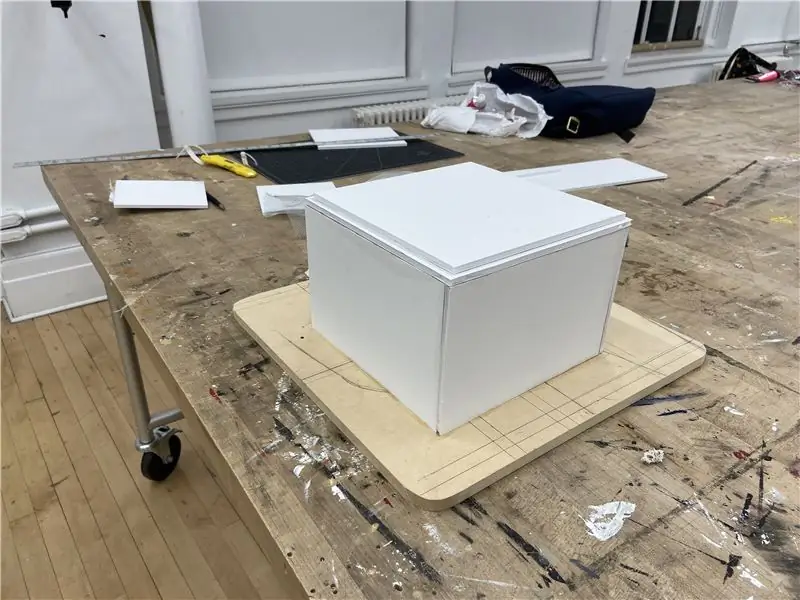
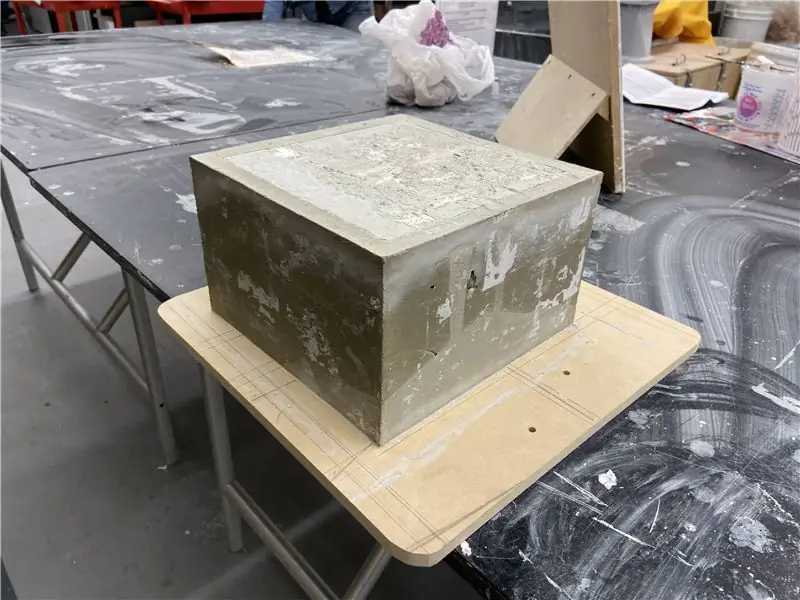
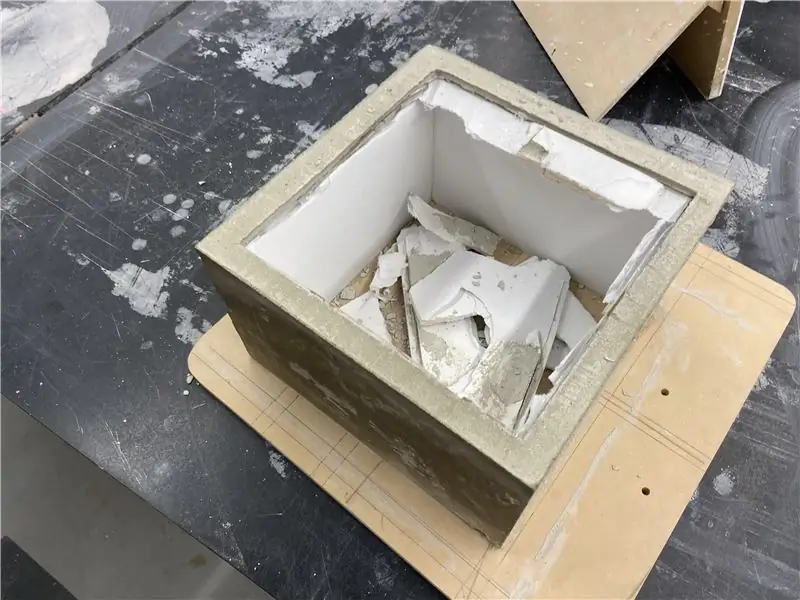
De doos is gemaakt van beton. Ik gebruik schuimplaten om een holle doos te maken om met beton te gieten. Laat het minimaal 24 uur drogen.
Stap 4: lasersnijden
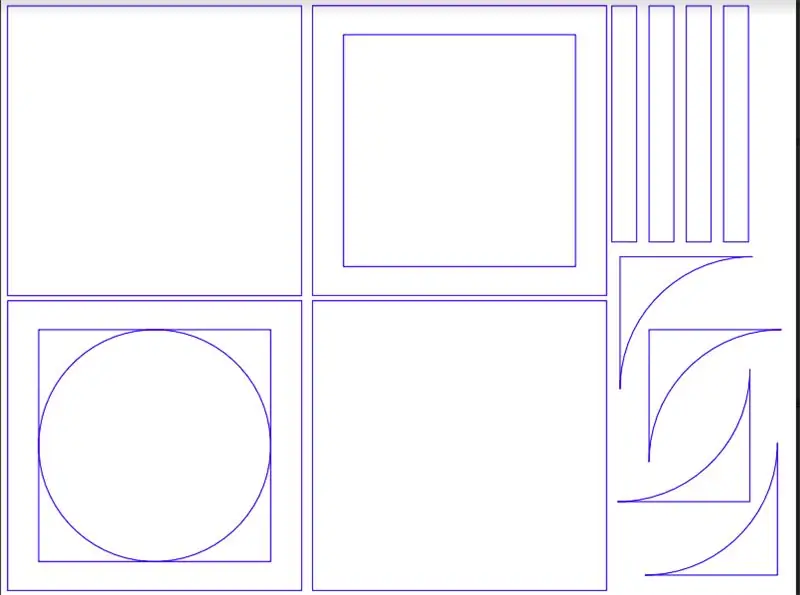
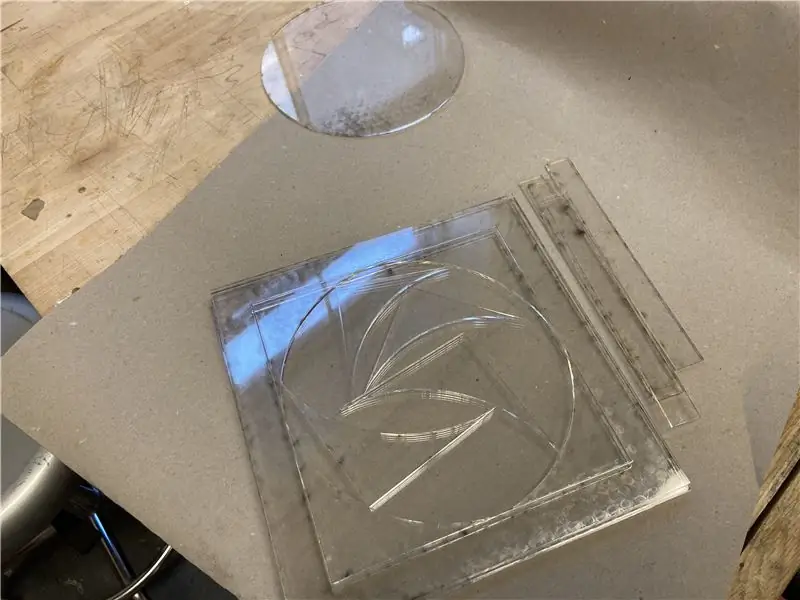
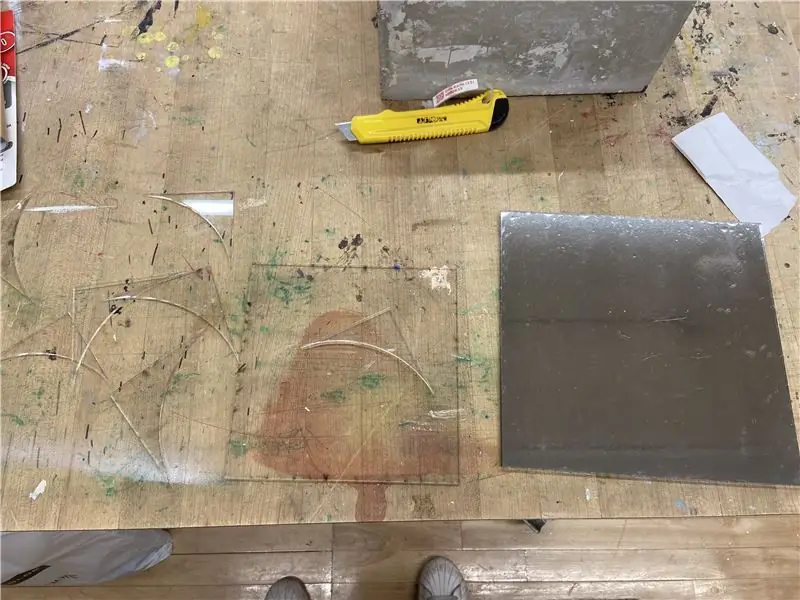
Het tekenen van de vorm past in de betonnen bak en snijd deze uit met lasersnijden.
Ik gebruik dit om verschillende ruimtes in de doos te stapelen: de reflectieruimte en de circuitruimte. Ik heb eenrichtingsspiegelraamfolie en dubbelzijdige spiegelfolie op de acrylvierkanten aangebracht.
Stap 5: LED-strip
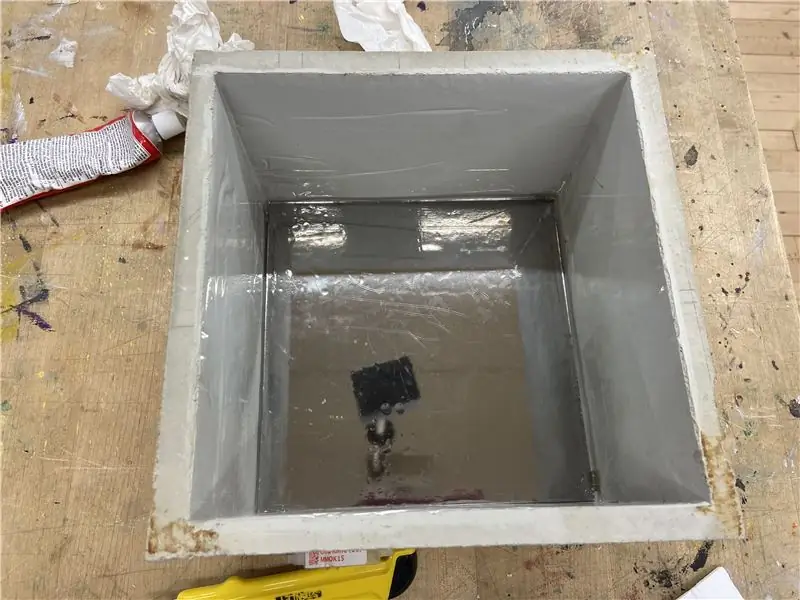
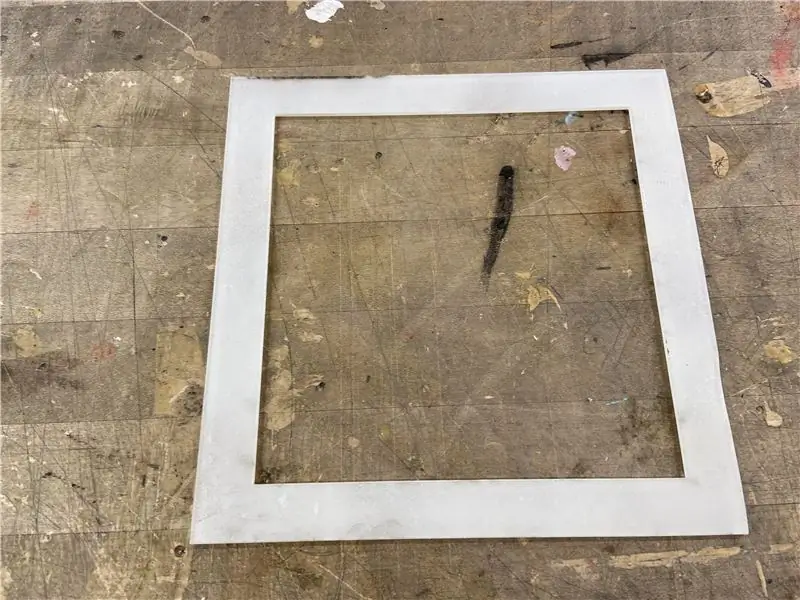
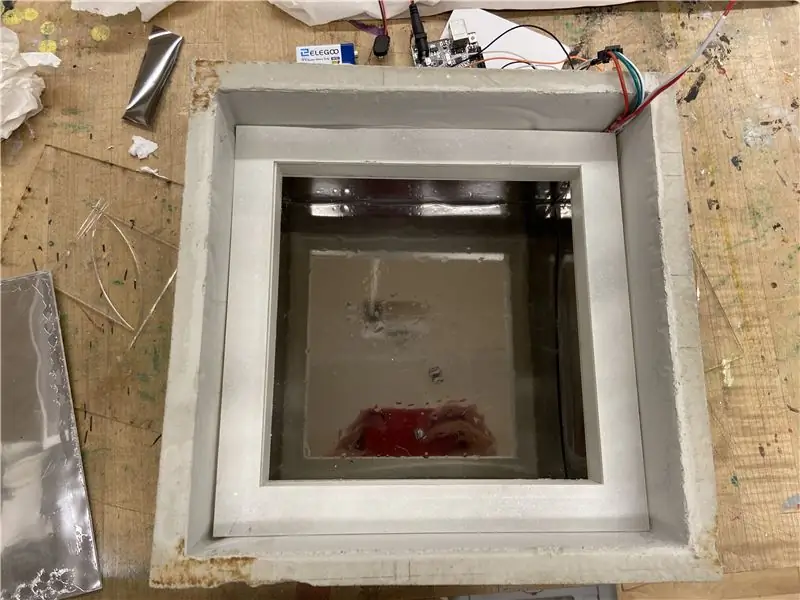
(aanzicht vanaf de onderkant van de doos)
Ik heb de eenrichtingsspiegelfilm eerst geplaatst, de spiegelzijde is naar de binnenkant van de doos gericht. En spuit witte kleur op het frame om een halftransparante buis voor de LED-strip te maken en plaats deze in het midden van de doos.
Stap 6: Circuit
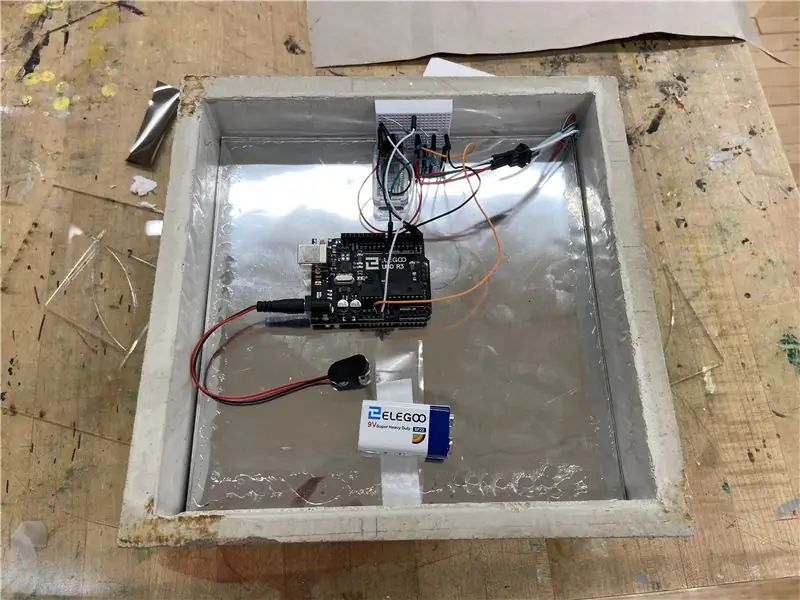
Plaats de dubbele zijspiegel acryl op de bovenkant van de LED en bevestig het circuit erop.
Aanbevolen:
Toegang krijgen tot een extern rootbestandssysteem met behulp van DB410 als een Ethernet-dongle: 6 stappen
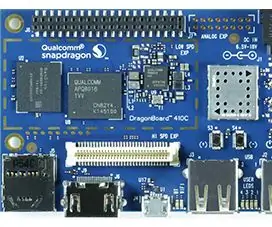
Toegang krijgen tot het externe rootbestandssysteem met behulp van DB410 als een Ethernet-dongle: Doelstellingen: Installeer de toolchain en hercompileer de kernel om ondersteuning voor USB Ethernet CDC-gadgets in te voegen; Maak boot.img opnieuw van Linaro om USB Ethernet CDC op te starten; Maak een NFS-server om het rootbestandssysteem te hosten; IP-configuratie in DEVICE en HOST
Nog een andere instructie over het gebruik van de DIYMall RFID-RC522 en Nokia LCD5110 met een Arduino: 8 stappen (met afbeeldingen)
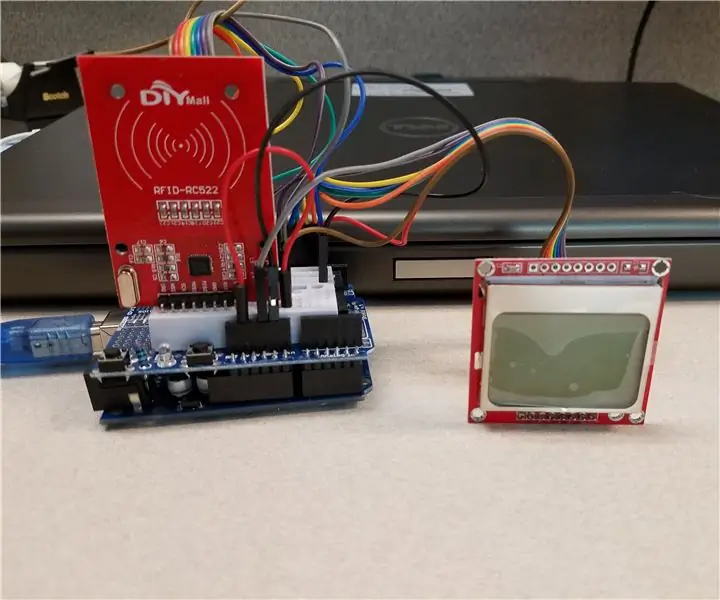
Nog een andere Instructable over het gebruik van de DIYMall RFID-RC522 en Nokia LCD5110 met een Arduino: waarom voelde ik de behoefte om nog een Instructable te maken voor de DIYMall RFID-RC522 en de Nokia LCD5110? Nou, om je de waarheid te zeggen, ik werkte ergens vorig jaar aan een Proof of Concept met beide apparaten en op de een of andere manier "misplaatst"
Een LAPTOP-CPU (en andere coole dingen!) Upgraden om een LANGZAME/DEAD-laptop in een SNELLE laptop te veranderen: 4 stappen

Een LAPTOP-CPU upgraden (en andere coole dingen!) om een LANGZAME/DEAD-laptop in een SNELLE laptop te veranderen! erg verouderd … Het LCD-scherm was kapot en de belangrijkste harde schijf was vastgelopen, dus de laptop was in wezen dood … Zie foto's en
Nog een andere flitsdiffusor (ontworpen voor een Canon 580EX II): 5 stappen
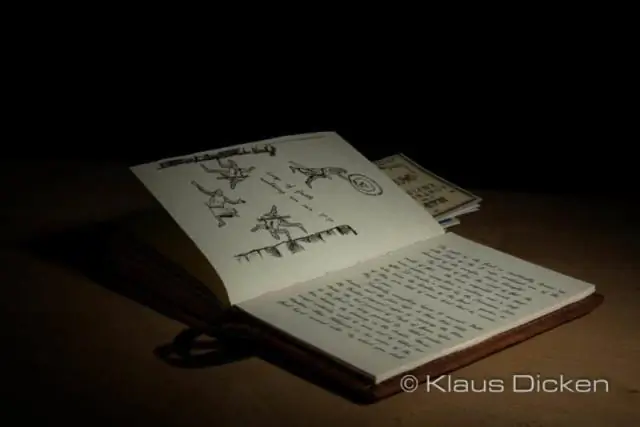
Nog een andere flitsdiffusor (ontworpen voor een Canon 580EX II): ik weet dat er een miljoen van zijn, maar ik heb er toch mijn eigen ontworpen. Ik wilde er een die goedkoop en draagbaar was, maar er enigszins professioneel uitzag, zodat mijn klanten niet zouden denken dat ik een totale amateur was. Deze diffuser is ontworpen voor de Canon 580
Statiefondersteuning voor een QuickCam (of andere webcam): 5 stappen

Statiefondersteuning voor een QuickCam (of andere webcam): Er zijn veel redenen waarom u uw webcam op een statief wilt plaatsen. Ik moest dit doen omdat de standaard voor mijn Logitech QuickCam Pro 4000 ontbrak, maar het is vaak leuk om met een statief te gebruiken voor betere foto's in het algemeen, vooral als je
